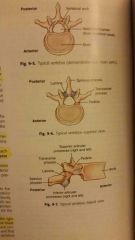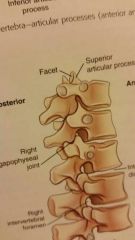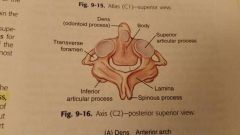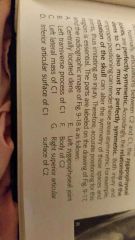![]()
![]()
![]()
Use LEFT and RIGHT arrow keys to navigate between flashcards;
Use UP and DOWN arrow keys to flip the card;
H to show hint;
A reads text to speech;
64 Cards in this Set
- Front
- Back
|
Spinal cord which is enclosed and protected by the spinal canal begins with the
|
Medulla oblongata
|
|
|
Lumbar puncture into the spinal canal is at the level of
|
L3 l4
|
|
|
It passes through the foramen Magnum of the skull and continues through the first cervical vertebra all the way down to the lower border of the first lumbar vertebra where it tapers off to a point called the
|
Conus medullaris
|
|
|
Conus medullaris is at level of
|
Lower l1
|
|
|
How many vertebra in adults and children
|
33 in a child 26 in an adult
|
|
|
The largest and strongest individual vertebra are the
|
5 Lumbar vertebra
|
|
|
Common sites of injury and pathology
|
The cartilaginous discs between the inferior lumbar vertebra
|
|
|
Which bones develop as multiple separate bones and fuse into two distinct bones
|
The sacrum and the Coccyx
|
|
|
After fusion into a single sacrum and a single coccyx the adult vertebral column is composed of an average of
|
26 separate bones
|
|
|
A rounded inward or depressed surface like a cave
|
Concave
|
|
|
a rounded outward or elevated surface
|
Convex
|
|
|
The cervical and lumbar regions have concave curvatures and are described as
|
Lordotic
|
|
|
The thoracic and sacral regions have
|
Convex curvatures
|
|
|
Soon after birth what curve began to develop
|
Thoracic and sacral (pelvis)
|
|
|
What are the two primary curves
|
Thoracic curvature which is convex and sacral curvature which is also convex
|
|
|
As children begin to raise their head and sit up, the first compensatory concave curve forms in which region
|
Cervical
|
|
|
The second compensatory concave curve develops when children learn to walk
|
The lumbar curvature
|
|
|
Lordosis means
|
Bent backward
|
|
|
Lordosis
|
Exaggerated lumbar curvature or swayback/ increased concavity
|
|
|
kyphosis
|
Meaning a hump or abnormal / exaggerated thoracic hump back curvature with increased convexity
|
|
|
An abnormal or exaggerated lateral curvature
|
Scoliosis which can produce a limp or an uneven walk, occurs in the lower vertebral column with a pronounced S shaped lateral curvature
|
|
|
A typical vertebra consists of two main parts
|
The body and the vertebral arch
|
|
|
The posterior surface of the body and the arch form a circular opening which is the
|
Vertebral foramen, which encloses the spinal cord
|
|
|
Which encloses and protects the spinal cord
|
The vertebral or spinal canal
|
|
|
What forms most of the sides of the vertebral arch
|
Pedicles which extend posteriorly from either side of the vertebral body
|
|
|
The posterior part of the vertebral arch is formed by two somewhat flat layers of bone called
|
Lamina
|
|
|
Extending laterally from approximately the junction of each pedicle and lamina is a projection termed the
|
Transverse process
|
|
|
This extends posteriorly to the midline junction of the two lamina
|
Spinous process
|
|
|
The most posterior extensions of the vertebra often which can be palpated along the posterior surface of the neck and back
|
Spinous processes
|
|

|
.
|
|
|
The typical vertebra consists of two particles and two women on that form the vertebral arch and the vertebral foramen containing the spinal cord, to transverse processes extending laterally 1 spinous process extending posteriorly and the large anterior body.
|
.
|
|
|
Each typical vertebra also has blank, to superior and inferior, which formulate the important joints of the vertebral column
|
Four articular processes
|
|
|
Could not occur without the spine which serves as a pivot point for arc like movement of the ribs
|
Respiration
|
|
|
The intervertebral joints are blank that are found between the vertebral bodies
|
amphiarthrodial joints
|
|

|
.
|
|
|
Facet is actually only the articulating surface instead of the entire superior or inferior articular process
|

|
|
|
The superior vertebral notch and the inferior vertebral notch form the
|
Intervertebral foramen
|
|
|
5 aspects of the vertebral column
|
Body, vertebral arch, joints, intervertebral foramina, intervertebral disc
|
|
|
The first started cervical vertebra has no
|
Body
|
|
|
The condition also known as slipped disc is termed
|
Herniated nucleus proposes or HNP
|
|
|
Outer fibrous portion of intervertebral disc
|
Annulus fibrosus
|
|
|
semigelatinous inner part of intervertebral disk
|
nucleus pulposus
|
|
|
Cervical vertebra have unique characteristics such as
|
Transverse foramina, bifid spinous process tips, overlapping vertebral bodies
|
|
|
another name for c1
|
atlas
|
|
|
Another name for c2
|
Axis
|
|
|
The vertebral prominens is at the level of
|
C7
|
|
|
Typical cervical vertebra are which cervical vertebraes
|
c3 to c6
|
|
|
One unique characteristic of all cervical vertebra
|
each has 3 foramina that run vertically, the right and left transverse foramina I am a single large vertebral foramen
|
|
|
The spinous processes of c2 through c6 are fairly short and end in double pointed or bifid tips
|
A second unique characteristic typical of cervical vertebra
|
|
|
To open up and radiographically demonstrate the cervical intervertebral foramina,
|
A 45 degree oblique position combined with a 15 degrees of Fallot angle of the x-ray beam would be required
|
|
|
The intervertebral foramina are situated at a
|
45 degree angle to the midsagittal plane, open anteriorly
|
|
|
the zygopophyseal joints of the 2nd through 7th cervical vertebra are located
|
At right angles or 90 degrees, to the midsagittal plane and thus are only visualized only in a true lateral position
|
|
|
in contrast to the other zygopophyseal joints, those between c1 and c2 are visualized only on a
|
True AP projection
|
|
|
atlas c1
|

|
|
|
axis c2
|

|
|
|
c1 and c2 oblique view
|

|
|
|
On c1, the Atlas, anteriorly there is no body but simply a thick arch of bone called the
|
Anterior arch. The anterior art include the small anterior tubercle
|
|
|
The dance, or odontoid process, is part of the second cervical vertebra but a superior perspective of c1 shows its location and how it is held in place by the
|
Transverse atlantal ligament
|
|
|
Rather than two lamina Anna spinous process found in typical vertebra, see one has a posterior arts that generally bears a small
|
Posterior tubercle at the midline
|
|
|
The articular pillars, they segments of bone between the superior and inferior articular processes, are called
|
Lateral masses for c1. Because the lateral masses of c1 support the weight of the head and assist in rotation of the head, these portions are the most bulky and solid part of c1
|
|
|
Rotation of the head primarily occurs between
|
C1 and c2 with the dens acting as a pivot
|
|

|

|
|
|
zygopophyseal joints demonstrated inwhat position
|
left lateral
|
|
|
intervertebral foramina demonstrated in
|
lpo or rao
|

